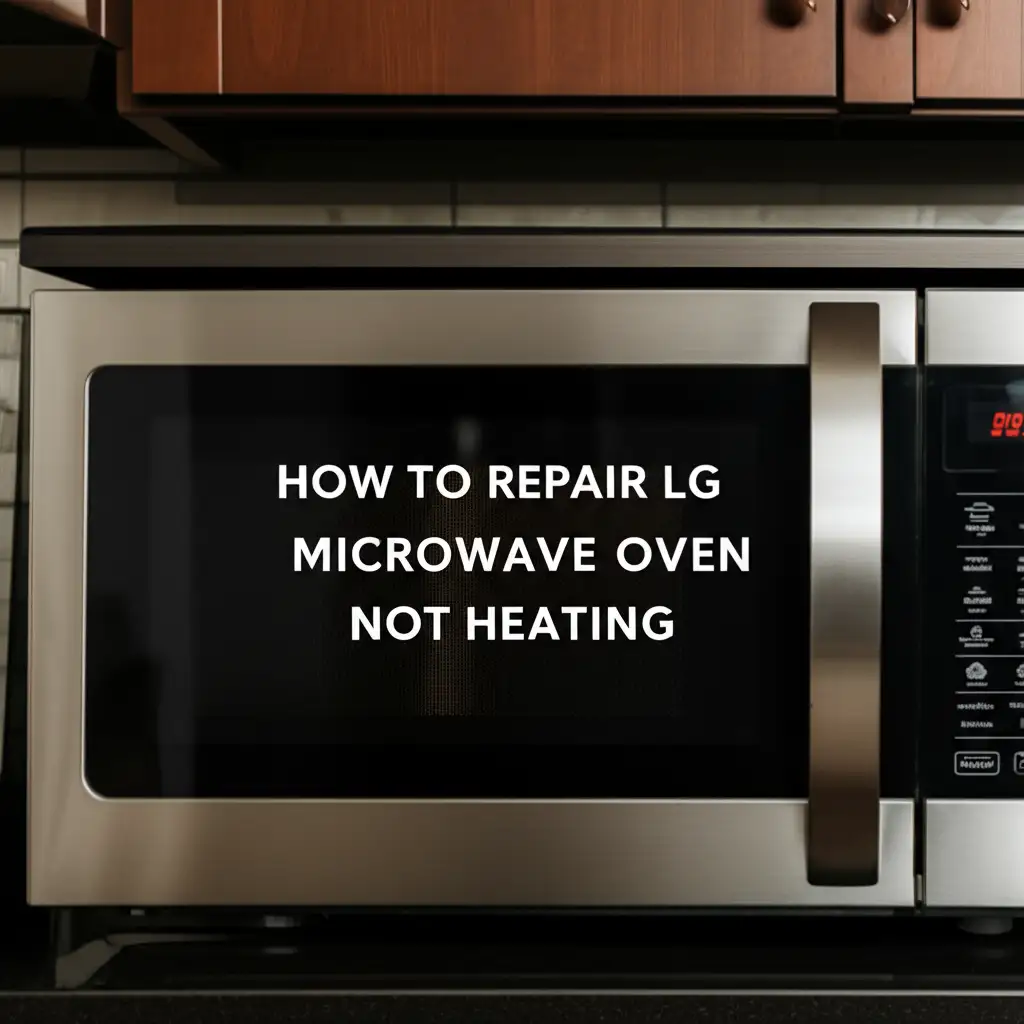· Todd Martin · Home Appliances · 17 min read
How To Install Kitchenaid Over The Range Microwave

Install Your KitchenAid Over-the-Range Microwave
Installing a new appliance in your kitchen can transform the space. A KitchenAid over-the-range microwave combines cooking power with valuable counter space. This guide provides clear steps to install your KitchenAid over-the-range microwave. You will learn about preparation, mounting, and connecting the unit.
You can achieve a professional-looking installation by following these instructions. This project adds both style and function to your home. I will help you understand each part of the process.
Takeaway:
- Gather all necessary tools and safety equipment before starting.
- Carefully follow the manufacturer’s specific instructions for your KitchenAid model.
- Ensure proper electrical and ventilation setup for safe operation.
- Get help for lifting the microwave, as it requires at least two people.
Installing a KitchenAid over-the-range microwave requires careful measurement, secure mounting, and proper electrical connection. You will mount a bracket on the wall, drill top cabinet holes, and secure the unit from above. Following the manufacturer’s guide ensures a safe and successful setup.
Essential Preparation: Before You Install Your KitchenAid Microwave
Before you begin to install your KitchenAid over-the-range microwave, proper preparation is important. This first step ensures safety and makes the entire process smoother. Gather all your tools and review the microwave’s instruction manual. This manual contains specific details for your exact KitchenAid model.
I always start by checking the electrical supply. Ensure a dedicated 120-volt, 15-amp, or 20-amp circuit is available. The outlet should be located inside the cabinet above where the microwave will sit. Do not plug the microwave into an extension cord. This is important for safety.
Next, collect all the tools you will need. This prevents interruptions during installation. A stud finder, level, drill, and various bits are common requirements. You will also need measuring tape, a pencil, and safety glasses. Having these items ready saves time. You can learn more about general requirements for over-the-range microwave installation by visiting our guide on Can I install an over-the-range microwave.
Confirm the dimensions of your new KitchenAid microwave. Compare them with the space above your range. Most over-the-range microwaves fit into a standard 30-inch wide opening. However, checking measurements ensures a proper fit. Make sure there is enough clearance from the cooking surface below.
Finally, prepare the work area. Clear any items from the stovetop and counter. Protect your countertops with a moving blanket or cardboard. This prevents scratches or damage during installation. Good lighting is also very helpful.
Safety First: Disconnecting Power and Clearing the Area
Safety is the first priority when starting any electrical appliance installation. Before touching any wires or mounting anything, turn off the power. Go to your home’s main electrical panel and locate the circuit breaker for your kitchen. Flip this breaker to the “off” position.
Verify the power is off using a non-contact voltage tester at the outlet where the microwave will connect. This simple step confirms the area is safe. Never assume the power is off. Always test it.
Next, ensure the work area is clear. Remove any pots, pans, or small appliances from the stovetop. Clear the countertop directly below and around the installation site. You will need clear access for drilling and lifting. Protecting your counters with a blanket or thick cloth helps prevent damage.
Having a clean and safe space makes the installation process much easier. It reduces the chance of accidents. Remember to wear safety glasses to protect your eyes from dust or debris. Gloves can also offer good grip and hand protection.
Removing Your Old Microwave: A Step-by-Step Guide
If you are replacing an existing over-the-range microwave, you must first remove the old unit. This process requires careful steps to ensure safety and prevent damage. Make sure the power is off at the circuit breaker before you touch anything. Always double-check this step.
Start by locating the electrical cord for the old microwave. It usually plugs into an outlet inside the cabinet above the microwave. Unplug the cord carefully. If the old unit is hardwired, you will need to disconnect the wiring inside a junction box. This should be done by a qualified electrician if you are unsure.
Next, find the mounting bolts. These bolts typically secure the microwave from the cabinet above. Open the upper cabinet doors and look for two or three bolts going down into the microwave’s top. Use a screwdriver or socket wrench to loosen and remove these bolts. Support the microwave from below as you remove the last bolt.
The old microwave also attaches to a wall mounting plate. This plate usually supports the microwave’s back. Once the top bolts are out, carefully tilt the microwave forward and lift it off the wall plate. This step often requires two people. One person supports the weight while the other lifts it off the bracket. If you need a more detailed guide on appliance removal, you can refer to our article on How to remove over the range microwave Whirlpool.
Finally, remove the old wall mounting plate. This plate is typically screwed into the wall studs. You will likely use a new mounting plate for your KitchenAid microwave. Removing the old one creates a clean slate for the new installation. Patch any holes if they will not be covered by the new bracket.
Mounting Bracket Setup: Securing Your KitchenAid Microwave
The wall mounting bracket is the foundation for your new KitchenAid microwave. Proper installation of this bracket ensures the microwave is secure and level. This is a critical step in the entire process. Do not rush this part.
First, you need to determine the correct height for the bracket. The microwave instruction manual will provide a template. This template usually shows where to drill holes and position the bracket. Tape the template to the wall, aligning it with the bottom edge of the upper cabinet. Make sure the template is level using a spirit level.
Next, locate the wall studs. A stud finder is essential for this. Mark the center of at least two wall studs where the mounting bracket will go. The bracket must be screwed into these studs for strong support. Do not rely on drywall anchors alone. The weight of the microwave requires solid wood framing. If you are installing over a tile backsplash, specific techniques are needed; consider our guide on How to install over the range microwave with tile backsplash.
Transfer the drill hole locations from the template to the wall. Mark the screw points for the bracket. Pre-drill pilot holes at these marked spots. Use a drill bit slightly smaller than the mounting screws. This prevents the wood from splitting and makes screwing easier.
Now, position the mounting bracket on the wall. Align the pre-drilled holes in the wall with the holes in the bracket. Use long, sturdy lag screws to attach the bracket firmly to the wall studs. Tighten the screws until the bracket is snug against the wall. Check again with your level to ensure the bracket is perfectly horizontal. A well-installed bracket provides a stable base for your microwave.
Drilling Top Cabinet Holes
Once the wall bracket is secure, you need to prepare the upper cabinet. This cabinet will provide the top mounting points for your microwave. The template you used earlier also guides you on these holes.
First, locate the center point of the microwave opening on the underside of the upper cabinet. The template will have specific marks for this. Place the template against the cabinet bottom, aligning it with the wall bracket. Use a pencil to mark the exact locations for the upper mounting bolts.
These holes will typically be two or three points. They should align with the bolt receivers on the top of the microwave. Use a drill with a large enough bit (often 3/8 inch or 1/2 inch, check your manual) to create these holes. Drill straight through the cabinet bottom. These holes will allow you to pass bolts from inside the cabinet down into the microwave.
If your cabinet has a finished bottom, you may want to use a spade bit or hole saw to create clean holes. Ensure no wires or pipes are above the drilling area. Always check inside the cabinet before drilling. Proper holes ensure the microwave bolts can pass through smoothly.
Ventilation Choices: Ducted, Ductless, or Vertical Exhaust
KitchenAid over-the-range microwaves offer different ventilation options. Understanding these options is important for proper installation and performance. You must choose the right setup for your kitchen. The three main types are ducted (exterior), ductless (recirculating), and vertical (top) exhaust.
A ducted system moves air from the microwave outside your home. This is the most effective way to remove smoke, steam, and cooking odors. It requires a duct pipe running from the microwave’s top or rear to an exterior wall or roof vent. If your home has an existing duct for a range hood, you can usually connect to it. Make sure the duct size matches the microwave’s requirements, typically 3 1/4” x 10” or 6” round. Our guide on How to install over the range microwave with vent offers further details on vented installations.
A ductless, or recirculating, system does not vent air outside. Instead, it filters the air and sends it back into the kitchen. This option is common where exterior venting is not possible. The microwave uses charcoal filters to absorb odors and grease. These filters need regular replacement. For a ductless setup, you typically need to reconfigure the blower motor inside the microwave. The manual will show how to rotate the blower to face forward for recirculation.
A vertical exhaust system is a type of ducted system that vents through the top of the microwave and then straight up through the cabinet. This usually requires a duct opening in the cabinet above. This setup is common when venting directly up into an attic or roof vent. You must ensure the damper (a flap that prevents backdraft) on the microwave’s top is oriented correctly for the chosen ventilation method.
Before lifting the microwave, configure the blower motor for your chosen ventilation method. The KitchenAid manual provides specific instructions for rotating the motor if needed. Most units come set up for top exhaust. If you choose rear exhaust or recirculation, you must change the motor’s direction.
Lifting and Securing the New KitchenAid Microwave
This step is where your new KitchenAid microwave finally goes into place. It requires careful coordination and often an extra set of hands. Do not attempt to lift the microwave alone. These units are heavy and awkward.
First, ensure the power cord is accessible. Before lifting the microwave, feed the power cord through the hole you drilled in the upper cabinet. This cord will plug into the outlet inside the cabinet. Do not plug it in yet. Leave enough slack for easy connection later.
Position one person at each end of the microwave. Lift the microwave and carefully align it with the wall mounting bracket. The bottom back edge of the microwave usually has hooks or slots that engage with the bracket. Tilt the microwave slightly upward as you bring it close to the wall. This helps the hooks slide onto the bracket.
Once the microwave is resting on the wall bracket, rotate it upwards against the wall. The front of the microwave should now be flush with the wall. While one person holds the microwave securely in place, the other can go into the upper cabinet.
From inside the upper cabinet, insert the mounting bolts through the pre-drilled holes. Guide them into the bolt receivers on the top of the microwave. Hand-tighten the bolts first to ensure they catch the threads. Then, use a screwdriver or socket wrench to tighten them fully. Tighten them firmly, but do not overtighten, as this could damage the microwave or cabinet. Ensure the microwave is snug against the wall and the cabinet.
Finally, check the alignment of the microwave. It should be level and securely attached to both the wall bracket and the upper cabinet. Give it a gentle shake to confirm it feels stable. This careful placement ensures safety and proper function.
Connecting Power and Ductwork
After securing the microwave, it’s time for the final connections. This includes the electrical power and, if applicable, the ventilation ductwork. Make sure the circuit breaker is still off during this part.
First, plug the microwave’s power cord into the electrical outlet inside the upper cabinet. Ensure the connection is firm. If your microwave is hardwired, connect the wires inside the junction box according to your local electrical codes and the manufacturer’s instructions. Match wire colors: black to black, white to white, and ground to ground. Consult a professional if you are uncertain about hardwiring. For more on hardwiring options, see Can an over the range microwave be hardwired.
Next, if you are using a ducted ventilation system, connect the ductwork. If you have a top exhaust, slide the duct pipe from the cabinet opening down into the microwave’s exhaust port. Secure it with tape or screws as recommended. For rear exhaust, ensure the duct is properly sealed to the microwave’s back vent. Use foil tape to seal all duct connections. This prevents air leaks and improves ventilation efficiency.
If you chose a ductless (recirculating) system, ensure the charcoal filters are installed. These filters typically slide into slots behind the microwave’s front grille. The grille usually unlatches or unscrews for access. Follow the manual’s specific instructions for filter installation. Without these filters, the recirculating system cannot effectively remove odors.
Double-check all connections. Make sure the power cord is not pinched. Ensure the ductwork is free of kinks and securely sealed. Proper connections are important for both safety and the microwave’s performance.
Final Connections and Testing Your KitchenAid Unit
With the microwave physically mounted, the final steps involve connecting any remaining components and thoroughly testing the unit. This ensures your new KitchenAid microwave functions correctly and safely. Take your time with these last details.
First, install any remaining components that came with the microwave. This often includes the grease filters and the charcoal filters (if using a recirculating system). The grease filters typically slide into slots on the underside of the microwave. Charcoal filters go behind the top grille. Refer to your KitchenAid manual for exact placement. These filters are important for the microwave’s performance and cleanliness. Our article on How to clean over the range microwave filters provides useful cleaning tips once you start using your new microwave.
Once all parts are in place, you can restore power. Go back to your main electrical panel. Flip the circuit breaker for the kitchen back to the “on” position. The microwave should now have power.
Now, test the microwave’s functionality. Start by setting the clock. Then, test the basic cooking functions. Place a cup of water inside and run the microwave for 30 seconds. Check if the water heats up. This confirms the microwave is heating properly.
Also, test the light and the fan. The light usually has settings for dim or bright. The fan typically has multiple speeds. Turn on the fan and listen to ensure it operates smoothly. For ducted systems, check if air is moving through the exterior vent. For recirculating systems, confirm air flows out the top front vents.
Listen for any unusual noises or smells. A slight “new appliance” smell is normal initially, but strong burning smells are not. If you notice any issues, turn off the power immediately and consult the troubleshooting section of your KitchenAid manual. A thorough test ensures your installation was successful and the microwave is ready for use.
Maintaining Your New KitchenAid Microwave
Installing your KitchenAid over-the-range microwave is a big step. Keeping it clean and well-maintained helps ensure its longevity and performance. Regular care prevents issues and keeps your kitchen fresh. I always make sure to clean my appliances often.
The most common maintenance task for an over-the-range microwave is cleaning. Wipe down the interior and exterior surfaces regularly with a soft, damp cloth and mild soap. This prevents food splatters and grease from building up. For stubborn stains inside, place a bowl of water with lemon slices in the microwave and run it for a few minutes. The steam will loosen dried food, making it easier to wipe away.
The grease filters located on the underside of the microwave need frequent cleaning. These filters catch grease and prevent it from entering the fan. Most KitchenAid grease filters are dishwasher safe. You can also wash them by hand in hot, soapy water. Clean them monthly or more often depending on your cooking habits. Dirty filters reduce airflow and ventilation efficiency.
If your microwave is a recirculating (ductless) model, it has charcoal filters. These filters absorb odors and smoke. Charcoal filters are not washable; they need replacement. Check your manual for the recommended replacement schedule, usually every six to twelve months. Replacing them ensures your kitchen stays odor-free.
Periodically check the mounting bolts inside the upper cabinet. Make sure they remain tight. Vibrations from use can sometimes loosen them over time. A quick check twice a year helps maintain the microwave’s secure position. Proper maintenance extends the life of your KitchenAid appliance and keeps it working efficiently for many years.
FAQ Section
Q1: Can I install a KitchenAid over-the-range microwave by myself?
A: You can install a KitchenAid over-the-range microwave as a DIY project. However, it requires basic electrical knowledge and precise measurements. The microwave is heavy, so you will need a second person to help lift and position the unit safely during installation. Always follow the specific instructions in your KitchenAid manual.
Q2: What tools do I need for KitchenAid microwave installation?
A: For installing a KitchenAid over-the-range microwave, you will need a stud finder, power drill with various bits, a level, measuring tape, and a pencil. You also need safety glasses, a screwdriver, and a socket wrench. Having all tools ready before starting speeds up the process significantly.
Q3: How do I know if my KitchenAid microwave needs to be vented outside?
A: Whether your KitchenAid microwave needs to be vented outside depends on your home’s setup and local codes. If your home has existing ductwork above the range, you can connect the microwave to it. If not, you can use a ductless (recirculating) system that filters and returns air. Check your specific KitchenAid model’s manual for ventilation options.
Q4: How do I remove the old microwave before installing the new KitchenAid?
A: To remove an old microwave, first turn off the power at the circuit breaker. Unplug the microwave’s power cord. Then, remove the mounting bolts from the cabinet above the microwave. Finally, lift the microwave off its wall mounting plate. You will need a second person to help support and lift the unit safely.
Q5: Can I hardwire my KitchenAid over-the-range microwave?
A: Most KitchenAid over-the-range microwaves come with a power cord that plugs into a standard 120-volt outlet. Some models may have options for hardwiring, but this usually requires specific wiring knowledge and adherence to electrical codes. Consult your microwave’s manual or a qualified electrician if you consider hardwiring.
Q6: How often should I clean the filters on my KitchenAid microwave?
A: You should clean the grease filters on your KitchenAid over-the-range microwave monthly, or more often with heavy cooking. Most grease filters are dishwasher safe. If your microwave has charcoal filters for recirculation, they are not washable and need replacement every 6-12 months, depending on usage.
Conclusion
Installing a KitchenAid over-the-range microwave is a rewarding home improvement project. It upgrades your kitchen’s look and adds valuable functionality. By following these clear steps, you can confidently install your new appliance. Remember that preparation, precise measurements, and safety are paramount for a successful outcome.
Take your time with each stage, from gathering tools to securing the unit. Always refer to your specific KitchenAid model’s manual for detailed instructions. The manual provides crucial diagrams and specifications. Getting help for the lifting stage is essential for safety.
With your new KitchenAid over-the-range microwave in place, you will enjoy a more efficient and modern kitchen. This project enhances your cooking space and increases your home’s value. Enjoy your newly installed microwave!





